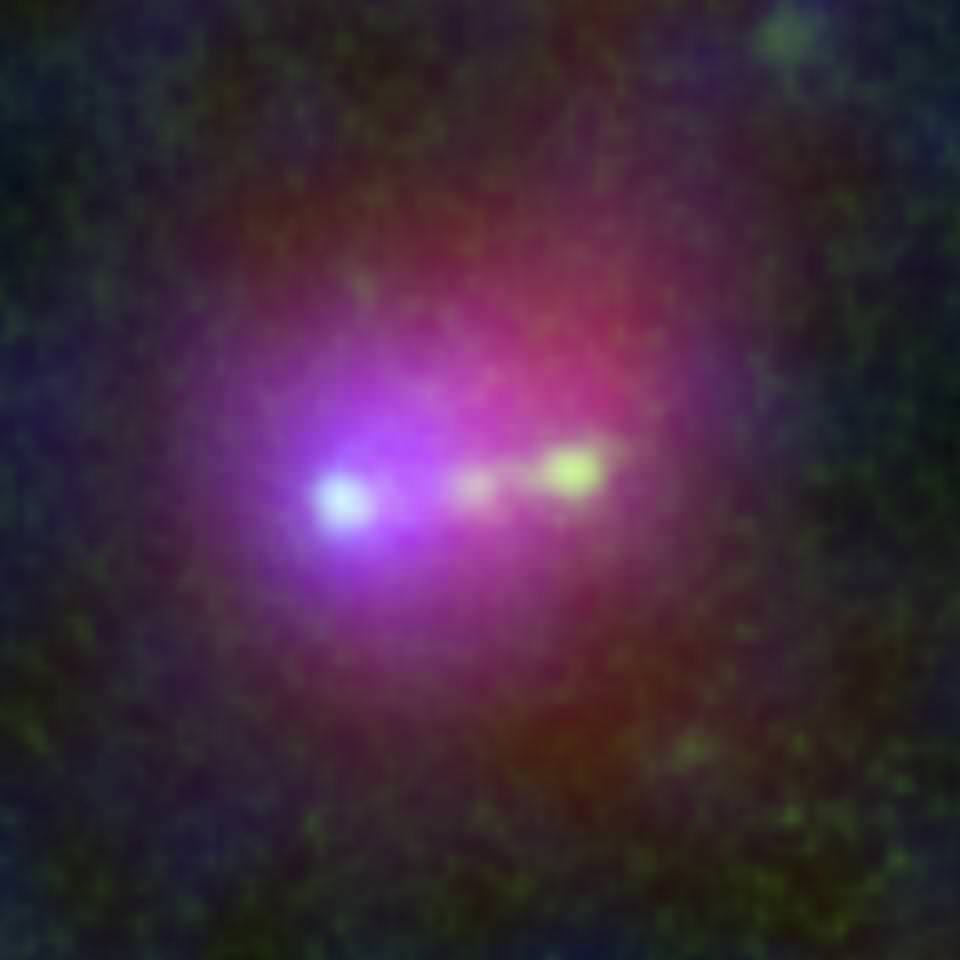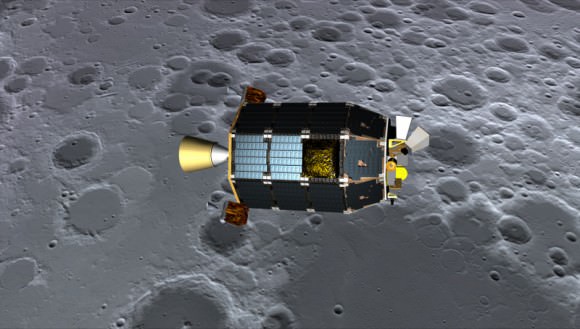Host: Fraser Cain
Guests: Nancy Atkinson, Amy Shira Teitel, David Dickinson
Continue reading “Weekly Space Hangout – November 22, 2013: MAVEN, Minotaur, Comet Nevski”

Space and astronomy news
Host: Fraser Cain
Guests: Nancy Atkinson, Amy Shira Teitel, David Dickinson
Continue reading “Weekly Space Hangout – November 22, 2013: MAVEN, Minotaur, Comet Nevski”

An enormous and incredibly luminous distant galaxy has turned out to actually be three galaxies in the process of merging together, based on the latest observations from ALMA as well as the Hubble and Spitzer space telescopes. Located 13 billion light-years away, this galactic threesome is being seen near the very beginning of what astronomers call the “Cosmic Dawn,” a time when the Universe first became illuminated by stars.
“This exceedingly rare triple system, seen when the Universe was only 800 million years old, provides important insights into the earliest stages of galaxy formation during a period known as ‘Cosmic Dawn’ when the Universe was first bathed in starlight,” said Richard Ellis, professor of astronomy at Caltech and member of the research team. “Even more interesting, these galaxies appear poised to merge into a single massive galaxy, which could eventually evolve into something akin to the Milky Way.”
In the image above, infrared data from NASA’s Spitzer Space Telescope are shown in red, visible data from NASA’s Hubble Space Telescope are green, and ultraviolet data from Japan’s Subaru telescope are blue. First discovered in 2009, the object is named “Himiko” after a legendary queen of Japan.
The merging galaxies within Himiko are surrounded by a vast cloud of hydrogen and helium, glowing brightly from the galaxies’ powerful outpouring of energy.
What’s particularly intriguing to astronomers is the noted lack of heavier elements like carbon in the cloud.
“This suggests that the gas cloud around the galaxy is actually quite primitive in its composition,” Ellis states in an NRAO video, “and has not yet been enriched by the products of nuclear fusion in the stars in the triple galaxy system. And what this implies is that the system is much younger and potentially what we call primeval… a first-generation object that is being seen. If true that’s very very exciting.”
Further research of distant objects like Himiko with the new high-resolution capabilities of ALMA will help astronomers determine how the Universe’s first galaxies “turned on”… was it a relatively sudden event, or did it occur gradually over many millions of years?
Watch the full video from the National Radio Astronomy Observatory below:
The research team’s results have been accepted for publication in the Astrophysical Journal.
Source: NASA/JPL press release and the NRAO.

Astrophotgrapher Sebastien Lebrigand lives along the flight path to the Charles de Gaulle Airport in Paris and regularly captures planes flying in front of the Moon (see another of his shots here). But this might be the image to end all ‘plane crosses in front of the Moon’ pictures. This plane is seriously taking over the Moon! Plus, its a great detailed shot of the lunar surface.
Sebastien took this image using a Canon EOS 60D, with a 102 mm refractor and 1320 mm of focal length.
Want to get your astrophoto featured on Universe Today? Join our Flickr group or send us your images by email (this means you’re giving us permission to post them). Please explain what’s in the picture, when you took it, the equipment you used, etc.
Last night, the US PBS television stations aired a new show from the series NOVA, “Asteroid — Doomsday or Payday.” It portrayed the two sides of asteroids: if a large asteroid collides with Earth, it could set off deadly blast waves, raging fires and colossal tidal waves. But on the other hand, some asteroids are loaded with billions of dollars’ worth of elements like iron, nickel, and platinum, and companies like Planetary Resources are trying to figure out how to take advantage of those elusive resources in space.
You can watch the entire episode below. As with previous shows, viewers in other countries might have difficulty watching the show.
For additional reading, here’s a great article by PBS’s NOVANext about why more isn’t being done about asteroid detection and deflection.
Here’s more info about the B612 Foundation that is featured in the show.
Planetary Resources has some info about why mining asteroids will fuel human expansion into the cosmos,(read here) — watch their video, below:

A volcanic eruption is creating a tiny new island off the coast of Japan. The Japanese Coast Guard snapped images and video of the eruption taking place, showing the new island being formed. Footage showed heavy smoke, ash and rocks spewing from the volcanic crater. As of this writing, experts say the small island is about 200 meters (660 feet) in diameter. It is located just off the coast of Nishinoshima, a small, uninhabited island in the Ogasawara chain, also known as the Bonin Islands, about about 620 miles (1,000 km) south of Tokyo.
See a video and additional images below.
Only time will tell if the island will remain or if the ocean waters will reclaim it. According to Yahoo News, Japan’s chief government spokesman said they would welcome any new territory.
“This has happened before and in some cases the islands disappeared,” Yoshihide Suga said when asked if the government was planning on naming the new island. “If it becomes a full-fledged island, we would be happy to have more territory.”


According to the Smithsonian Global Volcanism Program website, the Japan, Taiwan, Marianas Region is a very active region in the Pacific Ring of Fire and most volcanoes in this region “result from subduction of westward-moving oceanic crust under the Asian Plate. In the Izu-Mariana chain, however, the crust to the west is also oceanic, forming more basaltic island arcs (but with volcanoes that are far more explosive than oceanic hotspot volcanoes).”
You can read more about this volcanic region here.
See an extensive gallery of images at Yahoo News.
Another blow was dealt to deep space exploration this past weekend. The announcement comes from Jim Green, NASA’s Planetary Science Division Director. The statement outlines some key changes in NASA’s radioisotope program, and will have implications for the future exploration of the outer solar system.

We’ve written about the impending plutonium shortage and what it means for the future of spaceflight, as well as the recent restart of plutonium production. NASA is the only space agency that has conducted missions to the outer planets — even the European Space Agency’s Huygens lander had to hitch a ride with Cassini to get to Titan — and plutonium made this exploration possible. Continue reading “NASA Halts Work on its New Nuclear Generator for Deep Space Exploration”
We’re all watching what’s happening with Comet ISON, and today, November 21, 2013 Astronomy Magazine and Discover Magazine are hosting a “Countdown to Comet ISON” Google Hangout event, where the magazines’ expert editors will have all your comet questions answered. all the action starts at 20:00 UTC (3 pm EST). With ISON reaching its brightest this month, Astronomy Editor-in-Chief Dave Eicher, Discover Editor-at-Large Corey Powell and several others will discuss things like:
· When and where can you spot Comet ISON?
· How best to photograph the comet
· What scientists hope to learn from ISON
· Other amazing facts about comets across the ages
We’ll post the video feed here when it goes live, but can also watch (and RSVP) at the G+ event page.
If you miss it live, you can watch the replay above.

Time to pull out your 3-D glasses (the red-blue kind works the best) and take a virtual spacewalk with this new video from ESA. It gives you that “Gravity”-type experience — without the spinning. But as you travel around on your jetpack, this VR video gives you a good appreciation for the size of the ISS. You also get to watch a Soyuz spacecraft undock and the docking of an Automated Transfer Vehicle.

Dust on the moon accumulates at a rate 10 times faster than previously believed, which could make it difficult for future human explorers to use solar power cells on the lunar surface, a new study says.
“You wouldn’t see it; it’s very thin indeed,” stated Brian O’Brien, a University of Western Australia professor who co-authored the research. “But, as the Apollo astronauts learned, you can have a devil of a time overcoming even a small amount of dust.”
O’Brien also developed the Lunar Dust Detector, an experiment that flew aboard three Apollo moon missions in the 1960s and 1970s. The experiment, which was about the size of a matchbox, had three tiny solar cells on board. Voltage from the experiment fell as dust accumulated.
His experiment was deployed on Apollo 12 (in 1969) and Apollos 14 and 15 (in 1971), then shut off in 1977 due to budget cutbacks.
In these years of data, electrical measurements showed that 100 microgams of lunar dust fell per year per square centimeter. “At that rate, a basketball court on the Moon would collect roughly 450 grams (1 pound) of lunar dust annually,” stated a press release from the American Geophysical Union.
Past models assumed that the dust built up because of meteor impacts and cosmic dust, but O’Brien’s data was far in excess of that. He suggested it could be because the moon has a “dust atmosphere” built up as individual particles jump between different locations.
“During each lunar day, solar radiation is strong enough to knock a few electrons out of atoms in dust particles, building up a slight positive charge,” the AGU stated.
“On the nighttime side of the Moon, electrons from the flow of energetic particles, called the solar wind, which comes off the sun strike dust particles and give them a small negative charge. Where the illuminated and dark regions of the moon meet, electric forces could levitate this charged dust, potentially lofting grains high into the lunar sky.”

This data especially has resonance for NASA now that its Lunar Atmosphere and Dust Environment Explorer (LADEE) spacecraft is orbiting about 155 miles (250 kilometers) above the moon. The agency is trying to learn more about how the dust environment on the moon works, particularly at the “terminator” — the point between light and darkness — where dust may levitate due to electrostatic charging.
“Something similar was reported by Apollo astronauts orbiting the Moon who looked out and saw dust glowing on the horizon,” stated Monique Hollick, who led the work and is also a researcher at the University of Western Australia.

NASA believed O’Brien’s data was lost for decades as the agency did not preserve the archival tapes, but in 2006 O’Brien — when he heard of NASA’s issue — informed them he still had the data.
“It’s been a long haul,” stated O’Brien. “I invented [the detector] in 1966, long before Monique was even born. At the age of 79, I’m working with a 23-year old working on 46-year-old data and we discovered something exciting—it’s delightful.”
The work was published this week in Space Weather and is available here.
Source: AGU

Since the beginning of the space age, radio waves have been used for communication with spacecraft. But last month, NASA’s Lunar Laser Communication Demonstration (LLCD) made history by using a pulsed laser beam to transmit data over the 385,000 km (239,000 miles) between the Moon and Earth at a record-breaking download rate of 622 megabits per second (Mbps). This was NASA’s first system for two-way communication using a laser instead of radio waves. In our previous article today, we described how NASA will test out the Optical PAyload for Lasercomm Science (OPALS) on the International Space Station to demonstrate how videos can be beamed to Earth via laser beam.
What are the challenges in testing out an entirely new way of doing communications and other systems like navigation using lasers in space?
Don Cornwell, LLCD manager, discusses the challenges and successes they’ve had so far in this new video:
“The big change is the ability to do it by light, because the data rates that we’ve now done are just the opening shot, so to speak,” Cornwell said. “Radio communications systems have served us very well for the past 50 years but they are starting to run out of bandwidth, so in other words because of the frequency they use you can only modulate a certain portion of that frequencies and unless you move to higher frequencies – and light is a higher frequency than radio waves– you can’t squeeze a lot more bandwidth out, but the light systems in space, … we’ve now opened up a whole new field where we’re getting started , but the sky’s the limit regarding how much we can do there.”
Using lasers will allow for increased bandwidth for image resolution and 3-D video transmission from deep space, as well as allowing for tele-operation for long distances, such as from the Earth to the Moon.
LLCD is a short-duration experiment and the precursor to NASA’s long-duration demonstration, the Laser Communications Relay Demonstration (LCRD). LCRD is a part of the agency’s Technology Demonstration Missions Program, which is working to develop crosscutting technology capable of operating in the rigors of space. It is scheduled to launch in 2017.
Meanwhile, NASA has three other laser technology demonstration missions in the offing, likely launching in 2015 and 2016. One is a solar sail demonstration will enable propellantless laser in-space navigation for missions such as advanced geostorm warning, economic orbital debris removal, and deep space exploration.